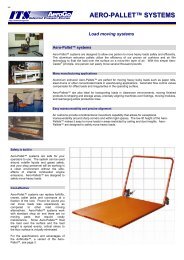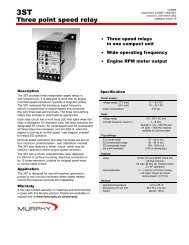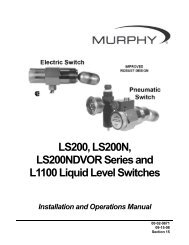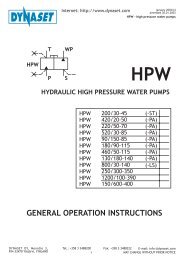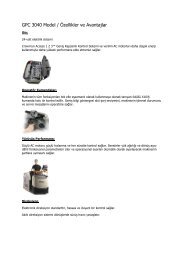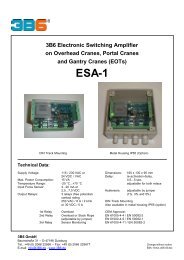CFD Modelling of 3-Way Catalytic Converter with ... - Rekarma
CFD Modelling of 3-Way Catalytic Converter with ... - Rekarma
CFD Modelling of 3-Way Catalytic Converter with ... - Rekarma
Create successful ePaper yourself
Turn your PDF publications into a flip-book with our unique Google optimized e-Paper software.
2004-01-0148<br />
<strong>CFD</strong> <strong>Modelling</strong> <strong>of</strong> 3-<strong>Way</strong> <strong>Catalytic</strong> <strong>Converter</strong>s <strong>with</strong> Detailed<br />
<strong>Catalytic</strong> Surface Reaction Mechanism<br />
Copyright © 2004 SAE International<br />
Ming Chen, Joe Aleixo, Shazam Williams & Thierry Leprince<br />
DCL International Inc.<br />
Yi Yong<br />
Fluent Inc.<br />
ABSTRACT<br />
This paper presents a 3-D <strong>CFD</strong> modelling <strong>of</strong> flow and<br />
heterogeneous reactions in catalytic converters. The<br />
pressure and velocity fields in the catalytic converters are<br />
calculated by the state <strong>of</strong> the art modelling technique for<br />
the flow resistance <strong>of</strong> catalyst substrate. A surface<br />
reaction model is applied to predict the performance <strong>of</strong> a<br />
three-way Pt/Rh catalyst. A reaction mechanism <strong>with</strong><br />
detailed catalytic surface reactions for the 3-way catalyst<br />
is applied. The novelty <strong>of</strong> this approach is the use <strong>of</strong> a<br />
surface chemistry solver coupled <strong>with</strong> a 3-D <strong>CFD</strong> code in<br />
the entire computational domain <strong>of</strong> the catalyst substrate<br />
that allows flow distribution for complex configurations to<br />
be accounted for. The concentrations <strong>of</strong> the gas species<br />
and the site species are obtained. A comparison<br />
between the simulation results and the experimental data<br />
<strong>of</strong> a three-way catalyst was made.<br />
INTRODUCTION<br />
The performance map <strong>of</strong> a catalyst is mainly determined<br />
by precious metal loading, catalyst formulation, exhaust<br />
gas conditions and aging history. Fig. 1 is a modified<br />
diagram <strong>of</strong> the regimes <strong>of</strong> catalytic surface reactions<br />
based on [1], parameterized by the Damköhler number<br />
(defined in Appendix) and the exhaust gas temperature.<br />
Depending on the state <strong>of</strong> the catalyst and upstream<br />
exhaust gas conditions, a catalytic converter is operated<br />
in any <strong>of</strong> the following three reaction regimes:<br />
1. In the intrinsic surface reaction regime, the Damköhler<br />
number is low, and the kinetics dominates over diffusion<br />
effects. The concentration gradients both in the<br />
washcoat pores and in the bulk gas are small.<br />
2. In the significant pore diffusion regime, the<br />
concentration gradients in the pores become significant<br />
as a result <strong>of</strong> the diffusion through pore structures and<br />
surface reactions. Moderate gradients <strong>of</strong> concentrations<br />
in the bulk gas are formed.<br />
3. The mass transfer regime corresponds to large<br />
Damköhler numbers. In this regime, the concentration<br />
gradients are very small <strong>with</strong>in the pores, and are large<br />
<strong>with</strong>in the boundary layer <strong>of</strong> the bulk gas. The reaction<br />
rate is limited by the mass transfer between the bulk gas<br />
and the outside surface <strong>of</strong> the washcoat.<br />
Because <strong>of</strong> the complexity associated <strong>with</strong> the<br />
quantitative description <strong>of</strong> the interactions among<br />
catalytic surface reactions, mass diffusion, fluid<br />
dynamics and heat transfer, catalyst modelling relies<br />
heavily on experiments.<br />
Intrinsic surface<br />
reaction regime<br />
Significant pore<br />
diffusion regime<br />
Mass transfer<br />
regime<br />
Fig. 1: Schematic <strong>of</strong> the regimes <strong>of</strong> catalytic surface reactions.<br />
Chemical reaction kinetics is a key aspect in the<br />
modelling <strong>of</strong> catalyst performance. Models <strong>of</strong> reaction<br />
kinetics for catalytic converters may be divided into two<br />
categories: (1) Langmuir-Hinshelwood type <strong>with</strong> few<br />
global reaction steps [2,3,4], (2) detailed catalytic surface<br />
reaction mechanism [5,6,7].<br />
In recent years, <strong>CFD</strong> simulation <strong>of</strong> catalytic converters<br />
using detailed catalytic surface reaction mechanisms has<br />
attracted interest, because it is believed that it allows a<br />
better prediction <strong>of</strong> the processes occurring in the<br />
converter, at extrapolated experimental conditions.<br />
Because a large amount <strong>of</strong> non-linear reaction
equations are included in the system, this approach<br />
requires a large computational capacity.<br />
Chatterjee et al. [5] proposed a 3-way reaction<br />
mechanism through collection <strong>of</strong> the available rate<br />
constants, <strong>with</strong> some adjustment to fit the experimental<br />
data. This mechanism was applied in a transient<br />
numerical study using a concept <strong>of</strong> representative<br />
channels [7] where the modelling was done using a 3-D<br />
<strong>CFD</strong> code coupled <strong>with</strong> a 2-D surface reaction model.<br />
The detailed flow distribution in the substrate is<br />
smoothed or averaged.<br />
In the present work, a surface chemistry solver coupled<br />
<strong>with</strong> a 3-D <strong>CFD</strong> code is used in the entire computational<br />
domain <strong>of</strong> the catalyst substrate. We attempt to validate<br />
the catalytic surface reaction model employed in<br />
FLUENT6.1.18 [8] <strong>with</strong> the reaction mechanism<br />
proposed by Chatterjee et al. For the purpose <strong>of</strong> flow<br />
calculation, the actual substrate is regarded as a porous<br />
medium and is treated as a fictitious continuum, such<br />
enabling the use <strong>of</strong> the partial differential equations in the<br />
whole computational domain. The effects <strong>of</strong> unresolved<br />
geometric surfaces <strong>of</strong> the channels in the substrate are<br />
included in the conservation equations for the species<br />
masses and energy. The porous medium assumption is<br />
a compromise to balance the complexity <strong>of</strong> the physics<br />
<strong>with</strong> the computational cost.<br />
In the following the mathematical formulations for the<br />
sub-models employed in the present study are<br />
introduced. These sub-models deal <strong>with</strong> the flow<br />
resistance <strong>of</strong> substrates, the heat transfer between<br />
substrates and gas, and catalytic surface reactions.<br />
Furthermore, specific simulation examples are provided<br />
to illustrate the applicability <strong>of</strong> these models.<br />
MODELLING OF THE CATALYTIC CONVERTER<br />
FLOW RESISTANCE OF THE SUBSTRATE<br />
The flow resistance coefficients <strong>of</strong> substrates are<br />
anisotropic and are practically deduced from<br />
experiments. They are specified along three directions<br />
based on the substrate type, the cell density, the<br />
hydraulic diameter and the resistance <strong>of</strong> the substrate.<br />
The empirical expression for calculating local pressure<br />
drop reads:<br />
∆P = a<br />
µ<br />
d<br />
L<br />
2<br />
h<br />
v +<br />
1<br />
2<br />
Y<br />
ρ<br />
g<br />
The resistance coefficient <strong>of</strong> the substrate, Y, is a<br />
function <strong>of</strong> cell density, substrate material and coating<br />
thickness. In the employed <strong>CFD</strong> s<strong>of</strong>tware package,<br />
FLUENT [8], porous media are modeled by the addition<br />
<strong>of</strong> source terms to the momentum equations <strong>of</strong> flow.<br />
The source term for the i th momentum equation reads:<br />
∂ p<br />
∂ x<br />
i<br />
= −<br />
3<br />
∑<br />
j=<br />
1<br />
D µ v<br />
ij<br />
j<br />
−<br />
1<br />
2<br />
3<br />
∑<br />
j=<br />
1<br />
v<br />
2<br />
C ρ | v | v<br />
ij<br />
j<br />
j<br />
(1)<br />
(2)<br />
When the direction <strong>of</strong> the i th coordinate coincides <strong>with</strong><br />
the longitudinal direction <strong>of</strong> substrate channels, one<br />
obtains the following expressions <strong>of</strong> the viscous<br />
resistance coefficient (D) and the inertial resistance<br />
coefficient (C):<br />
D a<br />
2 ii<br />
= /d<br />
h<br />
D = D = + ∞<br />
jj<br />
kk<br />
C ii<br />
= Y/L<br />
C = C = + ∞<br />
jj<br />
kk<br />
(3)<br />
(4)<br />
(5)<br />
(6)<br />
The non-diagonal components <strong>of</strong> the matrices C and D<br />
are zero. Here the subscripts j and k denote the other<br />
two coordinate directions <strong>of</strong> a Cartesian coordinate<br />
system. For a better convergence <strong>of</strong> the numerical<br />
solution, D<br />
jj<br />
and D<br />
kk<br />
, C<br />
jj<br />
and C are practically assumed<br />
kk<br />
as 1000 times <strong>of</strong> D ii<br />
and C ii<br />
, respectively. Table 1<br />
summarizes the flow resistance coefficients <strong>of</strong> a metallic<br />
substrate <strong>with</strong> different cell density. Eqs. (5) and (6) are<br />
only valid for a flow-through substrate <strong>with</strong> no flow<br />
through the walls.<br />
Table 1. Flow resistance coefficients, L = 0.09 m.<br />
cell density (cpsi) 200 300 400<br />
C ii [m -1 ] 8.48 8.66 8.91<br />
D ii [m -2 ] 1.25x10 7 1.78x10 7 2.74x10 7<br />
HEAT TRANSFER BETWEEN SUBSTRATE AND<br />
EXHAUST GAS<br />
The energy equation <strong>of</strong> gas phase and the energy<br />
equation <strong>of</strong> solid phase are coupled by a heat transfer<br />
coefficient:<br />
h = Nu λ<br />
g<br />
/d<br />
h<br />
(7)<br />
Here the Nusselt number Nu is assumed as a constant<br />
following [11]. In FLUENT a dual cell mesh technique is<br />
employed which allows a cell based heat transfer<br />
between the gas phase and the solid phase <strong>with</strong>in the<br />
concept <strong>of</strong> porous medium treatment.<br />
MODELLING OF CATALYTIC SURFACE REACTIONS<br />
Reaction Mechanism - Following [5], a surface reaction<br />
mechanism for a Pt/Rh three-way catalyst is applied,<br />
which consists <strong>of</strong> 60 elementary reaction steps and one<br />
global reaction step, involving 8 gas species and 23 site<br />
species. It includes the steps <strong>of</strong> adsorption <strong>of</strong> the<br />
reactants on the active sites <strong>of</strong> the surface, reaction <strong>of</strong><br />
the adsorbed species, and desorption <strong>of</strong> the reaction<br />
products. The mechanism consists <strong>of</strong> three parts: (1) a<br />
mechanism <strong>of</strong> C 3 H 6 oxidation on Pt/Al 2 O 3 , (2) a<br />
mechanism <strong>of</strong> NO reduction on Pt, (3) a mechanism for<br />
NO reduction and CO oxidation on Rh. The standard<br />
formation enthalpies <strong>of</strong> the adsorbed species are taken<br />
from [12].
Surface Reaction Model - The heterogeneous reaction<br />
is <strong>of</strong> the general form<br />
Ng<br />
∑<br />
i=<br />
1<br />
g<br />
where G i and S i represent the gas species and the site<br />
species (adsorbed species), respectively.<br />
The rate <strong>of</strong> r th forward reaction reads:<br />
R<br />
The forward rate constant for r th reaction, k f,r is given by<br />
k<br />
'<br />
i,r<br />
f,<br />
r<br />
G<br />
i<br />
= A<br />
g<br />
+ s<br />
s<br />
'<br />
''<br />
∑ s<br />
i,r<br />
S<br />
i<br />
→ ∑ gi,r<br />
G<br />
i<br />
+ ∑ s<br />
r<br />
N<br />
i=<br />
1<br />
β ⎛ Er<br />
⎞<br />
r<br />
T exp⎜<br />
− ⎟<br />
( 10)<br />
⎝ RT ⎠<br />
A r is adjustable due to surface site coverage. The latter<br />
is defined as the fraction <strong>of</strong> surface sites covered by the<br />
species. Because <strong>of</strong> the original implementation <strong>of</strong> the<br />
code and lack <strong>of</strong> data, the coverage dependence <strong>of</strong> the<br />
rate constant is accounted for by an ad hoc expression<br />
E<br />
r<br />
= E<br />
r,0<br />
− σ Θ<br />
i<br />
(11)<br />
Here E is the activation energy taken from the original<br />
r,0<br />
reaction mechanism, σ is an adjusting parameter, and<br />
Θ<br />
i<br />
the surface coverage <strong>of</strong> species i. The above<br />
expression is only applied for few selected critical<br />
reaction steps.<br />
For adsorption reactions, the rate constant is calculated<br />
by<br />
0<br />
ads S<br />
i R T<br />
k<br />
f, r<br />
=<br />
( 12)<br />
τ<br />
Γ 2π<br />
Mw<br />
i<br />
0<br />
Where S is the initial sticking coefficient. Γ is the<br />
i<br />
surface site density, and τ is the number <strong>of</strong> sites<br />
occupied by the adsorbing species.<br />
The concentration <strong>of</strong> the site species i is given by<br />
N<br />
i=<br />
1<br />
Ng<br />
' '<br />
g<br />
= ∏<br />
i, r s i, r<br />
r<br />
k<br />
f,r<br />
[G<br />
i<br />
]<br />
wall<br />
[Si<br />
]<br />
wall<br />
i=<br />
1<br />
( 8)<br />
[Si ]<br />
wall<br />
= Γ Θi<br />
( 13)<br />
Since the creation or depletion <strong>of</strong> species through<br />
heterogeneous reactions must be balanced by the mass<br />
flux through the surface, one obtains:<br />
N<br />
i=<br />
1<br />
''<br />
i,r<br />
S<br />
i<br />
(9)<br />
species, D i, is temperature dependent, and is calculated<br />
following [10]. F is the ratio between catalytic surface and<br />
geometric surface. Because the local concentration<br />
gradients in the washcoat pores are not numerically<br />
resolved, the effectiveness factor, η , is introduced to<br />
take account <strong>of</strong> the effects <strong>of</strong> pore diffusion in the<br />
washcoat. The effectiveness factor is dependent on pore<br />
tortuosity, washcoat thickness, mass diffusivity,<br />
concentrations <strong>of</strong> gas phase at the washcoat and<br />
intrinsic surface reaction rates [1]. The effectiveness<br />
factor is estimated by a simplified analytical solution <strong>of</strong> a<br />
catalyst <strong>with</strong> CO as species [1].<br />
The variation <strong>of</strong> the surface coverage is given by<br />
∂ Θ )<br />
i<br />
Γ = Ri,site<br />
i = 1, 2,3, ⋅ ⋅ ⋅,N<br />
s<br />
∂ t<br />
R )<br />
R ) i,gas<br />
and<br />
i, site<br />
are the net reaction rates <strong>of</strong> the gas<br />
species and site species, respectively.<br />
) rxn<br />
'' ''<br />
Ri, gas<br />
= ∑(gi,r<br />
− gi,r<br />
)Rr<br />
i = 1,2,3, ⋅ ⋅⋅,N<br />
g<br />
( 16)<br />
r=<br />
1<br />
) rxn<br />
'' ''<br />
Ri, site<br />
= ∑(s<br />
i,r<br />
− s<br />
i,r<br />
)Rr<br />
i = 1,2,3, ⋅ ⋅⋅,N<br />
s<br />
( 17)<br />
r=<br />
1<br />
RESULTS AND DISCUSSIONS<br />
CASE STUDY OF FLOW CHARACTERISTICS IN<br />
CATALYTIC CONVERTERS<br />
In order to use a multi-dimensional <strong>CFD</strong> code to simulate<br />
heterogeneous reactions in practical conditions, one first<br />
needs to predict the flow field in the exhaust pipes,<br />
cones and catalyst substrates. In the following, the flow<br />
characteristics for a typical catalytic converter are<br />
numerically investigated.<br />
γ<br />
1<br />
0.8<br />
(15)<br />
0.6<br />
200 cpsi<br />
0.4<br />
300 cpsi<br />
400 cpsi<br />
0.2<br />
7000 10000 13000 16000 19000 22000 25000<br />
Re<br />
∂ Y<br />
ρDi<br />
∂n<br />
i,wall<br />
)<br />
= η FMw R<br />
i<br />
i,gas<br />
i = 1, 2,3, ⋅ ⋅ ⋅,<br />
N<br />
g<br />
(14)<br />
Fig.2: The calculated flow uniformity index, γ , at the front face <strong>of</strong> the<br />
substrate. Both the Reynolds number and the cell density are varied.<br />
The substrate is metallic. The flow resistance coefficients are taken<br />
from Table 1.<br />
For unresolved surfaces, the term on the l. h. s. <strong>of</strong> Eq.<br />
(14) can be expressed as k m,i ⋅ρ⋅(Y i - Y i,wall ). Here k m,i is<br />
the mass transfer coefficient. The mass diffusivity <strong>of</strong> the<br />
A cylindrical metallic substrate <strong>with</strong> a length <strong>of</strong> 9 cm and<br />
a diameter <strong>of</strong> 7.6 cm is connected to two cones <strong>with</strong> a<br />
cone angle <strong>of</strong> 45°. The inlet and outlet pipe diameters
are 1/3 <strong>of</strong> the substrate diameter, respectively. The<br />
Reynolds number, which is based on the inlet pipe<br />
diameter, is varied from 8000 to 24000. The exhaust gas<br />
has a temperature <strong>of</strong> 700 K. The outer walls are<br />
assumed adiabatic. The flow in the substrate, which is<br />
represented by a porous zone, is laminar. The flow in the<br />
remaining part <strong>of</strong> the domain is turbulent. The turbulence<br />
is modeled by the standard k-є turbulence model. The<br />
mesh consists <strong>of</strong> 93000 non-uniform hexahedral cells.<br />
CASE STUDY OF CATALYTIC SURFACE REACTIONS<br />
Geometry and Boundary Conditions - A comparison is<br />
made between the simulated catalyst performance and<br />
the experimental data. The latter was obtained by a test<br />
on a laboratory-scale tube reactor [5, 9]. A catalyst, as<br />
summarized in Table 2, is located in the tube. The inlet<br />
and outlet faces are located 10 mm upstream and<br />
downstream <strong>of</strong> the catalyst, respectively. Fig. 5 shows<br />
the geometry and computational domain. The<br />
compositions <strong>of</strong> the nearly stoichiometric mixture are<br />
given in Table 3. The inlet flow is assumed as uniform,<br />
and the gas velocity is 1.35 m/s evaluated at 300 K,<br />
which corresponds to a space velocity <strong>of</strong> 168,000 1/h.<br />
The flow in the porous region and the other fluid zones<br />
are laminar. The inlet gas temperature is varied from<br />
500 K to 800 K.<br />
catalyst<br />
Fig. 3: The contours <strong>of</strong> the static pressure on a cross section. The cell<br />
density is 300 cpsi, and the Reynolds number is 16000.<br />
Fig. 5: The geometry and the surface mesh.<br />
Table 2. Catalyst data [5].<br />
Precious metal loading 50 g/ft 3 , Pt/Rh = 5:1<br />
Fig. 4: The velocity vectors on the cross section. The cell density is<br />
300 cpsi, and the Reynolds number is 16000.<br />
The flow in the catalytic converter is determined by the<br />
geometrical configuration, the flow resistance<br />
characteristic <strong>of</strong> the substrate and the Reynolds number.<br />
Fig. 2 indicates that the calculated flow uniformity index<br />
at the front face <strong>of</strong> the substrate is decreased <strong>with</strong> the<br />
increasing <strong>of</strong> the Reynolds number, and increased <strong>with</strong><br />
the increasing <strong>of</strong> the cell density. Fig. 3 and Fig. 4 show<br />
the contours <strong>of</strong> the static pressure and the velocity<br />
vectors at a cross section, respectively. It is shown that a<br />
large recirculation zone is formed in the diffuser. When<br />
the flow enters the porous zone, it aligns <strong>with</strong> the<br />
channel direction. The higher pressure is located around<br />
the catalyst entrance and the centre line.<br />
Substrate material<br />
Cell density<br />
Washcoat material<br />
Substrate length<br />
Substrate diameter*<br />
cordierite<br />
400 cpsi<br />
ceria stabilized γ -alumina<br />
29 mm<br />
10 mm<br />
Surface site density 2.72 Х 10 -9 mol/cm 2<br />
Geometric surface area per<br />
unit volume<br />
2740 m 2 /m 3<br />
Ratio <strong>of</strong> active metal surface<br />
and geometric surface<br />
70<br />
* The diameter <strong>of</strong> the substrates is defined by the authors.<br />
Table 3. Volumetric inlet concentrations <strong>of</strong> the species.<br />
CO 1.42 [%]<br />
O 2 0.77 [%]<br />
C 3 H 6 0.0450 [%]<br />
NO 0.1000 [%]<br />
N 2<br />
Balance
Results and Discussions - In Fig. 6, the calculated<br />
conversion efficiencies <strong>of</strong> CO, NO and C 3 H 6 are shown<br />
as a function <strong>of</strong> the inlet temperature for the mixture in<br />
Table 3. The conversion <strong>of</strong> CO, NO and C 3 H 6 begins at<br />
550 K. At the temperature <strong>of</strong> 700 K, the conversion<br />
efficiencies reach the maximum values. The calculated<br />
conversion <strong>of</strong> CO is 88% at 800 K, which is consistent<br />
<strong>with</strong> the concentration <strong>of</strong> O 2 in the mixture.<br />
Mass fraction <strong>of</strong> CO<br />
1<br />
Conversion <strong>of</strong> CO<br />
0.8<br />
0.6<br />
0.4<br />
0.2<br />
Simulation<br />
Experiment<br />
Mass fraction <strong>of</strong> CO 2<br />
0<br />
500 550 600 650 700 750 800 850<br />
1<br />
Conversion <strong>of</strong> NO<br />
0.8<br />
0.6<br />
0.4<br />
0.2<br />
Simulation<br />
Experiment<br />
Mass fraction <strong>of</strong> NO<br />
0<br />
500 550 600 650 700 750 800 850<br />
1<br />
Conversion <strong>of</strong> C3H6<br />
0.8<br />
0.6<br />
0.4<br />
0.2<br />
0<br />
500 550 600 650 700 750 800 850<br />
Inlet Temperature (K)<br />
Simulation<br />
Experiment<br />
Mass fraction <strong>of</strong> C 3 H 6<br />
Fig. 6: The conversion efficiency <strong>of</strong> CO, NO and C 3H 6. The<br />
experimental data are from [5,9].<br />
Fig. 7: The contours <strong>of</strong> the mass fractions <strong>of</strong> CO, CO 2, NO and<br />
C 3H 6 at 800 K.
0.02<br />
species are reasonably predicted using the surface<br />
reaction model <strong>with</strong> the detailed reaction mechanism.<br />
Mass Fraction [-]<br />
0.015<br />
0.01<br />
0.005<br />
0<br />
0.0 0.5 1.0 1.5 2.0 2.5 3.0<br />
Axial distance [cm]<br />
Fig. 8: The mass fractions <strong>of</strong> CO, NO, C 3H 6 , O 2 and CO 2 along the<br />
centre line <strong>of</strong> the catalyst, at 800 K.<br />
There is a competition between CO and C 3 H 6 for O 2 . In<br />
the temperature range between 750 K and 800 K, there<br />
is a slight increase <strong>of</strong> the calculated conversion<br />
efficiency <strong>of</strong> CO, accompanied by a slight decrease <strong>of</strong><br />
the conversion efficiency <strong>of</strong> C 3 H 6. The under-estimation<br />
<strong>of</strong> the C 3 H 6 conversion at 800 K could be corrected by a<br />
tuning <strong>of</strong> the kinetics parameters. The NO is completely<br />
converted at 750 K. The calculated light-<strong>of</strong>f curves agree<br />
well <strong>with</strong> the experimental data, especially at high<br />
temperature.<br />
Fig. 7 shows the contours <strong>of</strong> the mass fractions <strong>of</strong> CO,<br />
CO 2 , NO and C 3 H 6 at the inlet gas temperature <strong>of</strong> 800 K.<br />
The mass fractions <strong>of</strong> CO, CO 2 , NO, C 3 H 6 and O 2 along<br />
the centre line <strong>of</strong> the catalyst are shown in Fig. 8. For<br />
the same case, the coverage <strong>of</strong> CO(s) on Pt is varied<br />
from 0.2 to 0.3. The O(s) coverage on Pt is decreased<br />
along the centre line. The Pt(s)/O(s) ratio is large<br />
because <strong>of</strong> the low oxygen concentration in the gas<br />
phase. The Rh surfaces are mainly covered <strong>with</strong> N(Rh).<br />
Along the centre line <strong>of</strong> the catalyst, the N(Rh) coverage<br />
is decreased, and the number <strong>of</strong> free Rh sites is<br />
increased.<br />
CONCLUSION<br />
CO<br />
NO × 10<br />
C3H6 × 10<br />
O2<br />
CO2<br />
The presented numerical study shows that the flow field<br />
in the catalytic converter is influenced by the flow<br />
resistance <strong>of</strong> the substrate for a given geometric<br />
configuration and at a given Reynolds number. The<br />
numerical examples indicate that the flow uniformity<br />
index at the front face <strong>of</strong> the substrate is decreased <strong>with</strong><br />
the increasing <strong>of</strong> the Reynolds number, and increased<br />
<strong>with</strong> the increasing <strong>of</strong> the cell density.<br />
A surface reaction model <strong>with</strong> moderate sophistication is<br />
applied to predict the performance <strong>of</strong> a three-way<br />
catalyst. The comparison between the present 3-D<br />
steady state <strong>CFD</strong> solutions and the experimental data<br />
shows that the conversion efficiencies for the interested<br />
REFERENCES<br />
1. Charles N. Satterfield, Mass Transfer in<br />
Heterogeneous Catalysis, Robert E. Krieger<br />
Publishing Company, Inc., 1981.<br />
2. S. E. Volt, et al., Kinetics Study <strong>of</strong> Carbon Monoxide<br />
and Propylene Oxidation on Platinum Catalysts, Ind.<br />
Eng. Chem. Prod., Res. Dev., 12, 294, 1973.<br />
3. S. H. OH and J. C. Cavendish, Mathematical<br />
<strong>Modelling</strong> <strong>of</strong> <strong>Catalytic</strong> <strong>Converter</strong> Light<strong>of</strong>f, AIChE<br />
Journal, Vol. 31, No. 6, 1985, pp. 935-949.<br />
4. G. C. Koltsakis, P. A. Konstantinidis, A. M.<br />
Stamatelos, Development and Application <strong>of</strong><br />
Mathematical Models for 3-way <strong>Catalytic</strong> <strong>Converter</strong>s,<br />
Applied Catalysis B: Environment, Vol. 12, 1997, pp.<br />
161-191.<br />
5. D. Chatterjee, O. Deutschmann and J. Warnatz,<br />
Detailed Surface Reaction Mechanism in a Three-<br />
<strong>Way</strong> Catalyst, Faraday Discuss., 2001, 119, p. 371-<br />
384.<br />
6. O. Deutschmann, R. Schmidt, F. Behrendt and J.<br />
Warnatz, Numerical <strong>Modelling</strong> <strong>of</strong> <strong>Catalytic</strong> Ignition,<br />
Twenty-Sixth Symposium (International) on<br />
Combustion, The Combustion Institute, 1996, pp.<br />
1747-1754.<br />
7. J. Windmann, J. Braun, P. Zacke, et al., Impact <strong>of</strong><br />
the Inlet Flow Distribution on the Light-Off Behavior<br />
<strong>of</strong> a 3-<strong>Way</strong> <strong>Catalytic</strong> <strong>Converter</strong>, SAE paper 2003-01-<br />
0937.<br />
8. FLUENT 6.1.18, FLUENT Inc.<br />
9. J. Braun, T. Hauber, H. Többen, P. Pazke, D.<br />
Chatterjee, O. Deutschmann and J. Warnatz,<br />
Influence <strong>of</strong> Physical and Chemical Parameters on<br />
the Conversion Rate <strong>of</strong> a <strong>Catalytic</strong> <strong>Converter</strong>: A<br />
Numerical Simulation Study, SAE paper 2000-01-<br />
0211.<br />
10. D. E. Rosner, Transport Processes in Chemically<br />
Reacting Flow Systems, Butterworths, 1986.<br />
11. S. Siemund, D. Schweich, J. P. Leclerc and J.<br />
Villermaux, <strong>Modelling</strong> Three-<strong>Way</strong> Monolithic<br />
<strong>Catalytic</strong> <strong>Converter</strong>: Comparison Between<br />
Simulation and Experimental Data, Catalysis and<br />
Automotive Pollution Control, III, Studies in Surface<br />
Science and Catalysis, Vol. 96, 1995.<br />
12. D. Chatterjee, Detaillierte Moderllierung von<br />
Abgaskatalysatoren, Ph.D. Thesis, Heidelberg<br />
University, Germany, 2001.<br />
CONTACT<br />
E-Mail: mchen@dcl-inc.com<br />
Website: www.dcl-inc.com
η internal effectiveness factor [-]<br />
µ dynamic viscosity [kg/(m·s)]<br />
DEFINITIONS, ACRONYMS, ABBREVIATIONS<br />
a entrance loss coefficient [-]<br />
A pre-exponential factor [mol, m, s]<br />
r<br />
C inertial resistance coefficient [m -1 ]<br />
D viscous resistance coefficient [m -2 ]<br />
D i mass diffusivity <strong>of</strong> species i [m 2 /s]<br />
Da Damköhler number [-]<br />
d<br />
h<br />
hydraulic diameter <strong>of</strong> the substrate [m]<br />
E r activation energy [J/kmol]<br />
F ratio between catalytic surface and geometric<br />
surface<br />
g stoichiometric coefficient for gas species [-]<br />
[G ] molar concentration <strong>of</strong> gas species i on surface<br />
i wall<br />
h heat transfer coefficient [J/(m 2 ⋅s⋅K)]<br />
k m,i mass transfer coefficient [m/s]<br />
L length <strong>of</strong> catalyst [m]<br />
M molecular weight [kg/kmol]<br />
w<br />
N number <strong>of</strong> species [-]<br />
n normal distance from cell centre to wall [m]<br />
p static pressure [Pa]<br />
∆ p drop <strong>of</strong> static pressure [Pa]<br />
v superficial gas velocity [m/s]<br />
R universal gas constant [J/kmol⋅K]<br />
R )<br />
i,gas<br />
net reaction rate <strong>of</strong> gas species [kmol/m 2 ⋅s]<br />
R )<br />
i,site<br />
net reaction rate <strong>of</strong> site species [kmol/m 2 ⋅s]<br />
Re Reynolds number based on the diameter <strong>of</strong><br />
inlet pipe<br />
s stoichiometric coefficient for site species [-]<br />
0<br />
S initial sticking coefficient [-]<br />
[S<br />
i<br />
] wall<br />
molar concentration <strong>of</strong> site species i on surface<br />
t time [s]<br />
T temperature [K]<br />
x coordinate [m]<br />
Y resistance coefficient <strong>of</strong> the substrate [-]<br />
Y i mass fraction <strong>of</strong> gas species [-]<br />
Y i,wall mass fraction <strong>of</strong> gas species at the wall <strong>of</strong><br />
substrate<br />
Greek symbols<br />
β temperature exponent [-]<br />
r<br />
γ flow uniformity index [-]<br />
Θ surface coverage [-]<br />
Γ surface site density [kmol/m 2 ]<br />
ρ density <strong>of</strong> gas [kg/m 3 ]<br />
λ<br />
thermal conductivity <strong>of</strong> gas [W/(m·K)]<br />
Subscript<br />
g<br />
s<br />
r<br />
rxn<br />
wall<br />
i<br />
j<br />
k<br />
Superscript<br />
ads<br />
'<br />
''<br />
APPENDIX<br />
γ VALUE<br />
gas; gas species<br />
solid; site species<br />
index <strong>of</strong> reaction step<br />
number <strong>of</strong> reactions<br />
solid surface <strong>of</strong> substrate<br />
species index; index <strong>of</strong> the coordinate<br />
index <strong>of</strong> the coordinate<br />
index <strong>of</strong> the coordinate<br />
adsorption<br />
reactant<br />
product<br />
The flow uniformity index, γ , is defined by<br />
γ = 1−<br />
N<br />
∑<br />
i=<br />
1<br />
| v<br />
i<br />
− v |<br />
X<br />
2 v X<br />
i<br />
v is the local gas velocity in the cell i, and v is<br />
where<br />
i<br />
the average gas velocity. X is the area <strong>of</strong> cell i, and X<br />
i<br />
is the cross section area. N is the number <strong>of</strong> the cells in<br />
the cross section.<br />
DAMKÖHLER NUMBER<br />
The Damköhler number is defined by<br />
k ⋅L<br />
Da =<br />
v<br />
where k is the overall rate constant [s -1 ].




